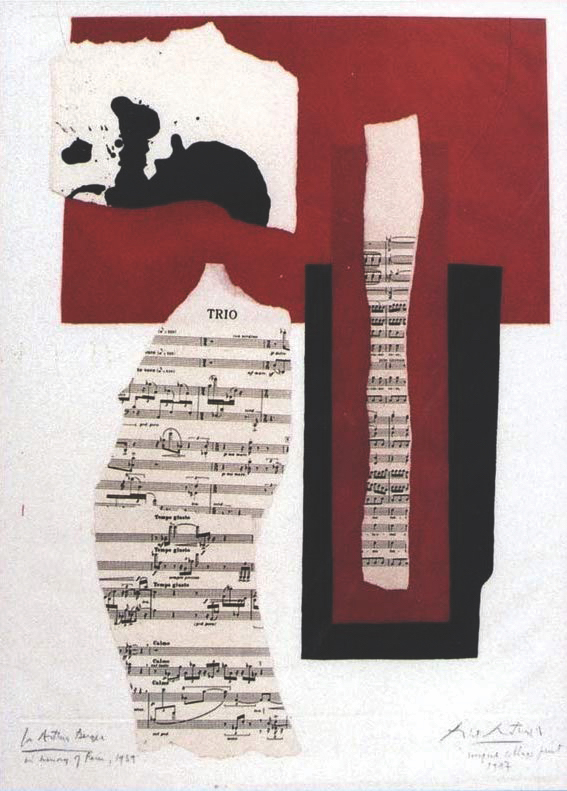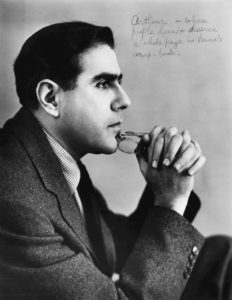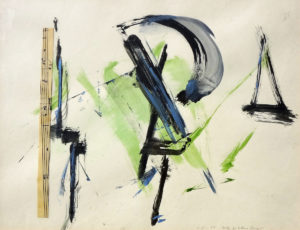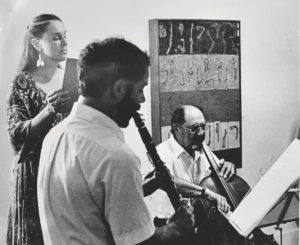A red sky is bisected by a darker red column, shadowed in black. Affixed are three paper fragments.

The one at left is sheet music from Arthur Berger’s Trio for Guitar, Violin, and Piano. The scrap on the right comes from Mozart’s Don Giovanni. Top left is one of Robert Motherwell’s famous ink splatters.
In the bottom left corner is scrawled, “For Arthur Berger, in Memory of Paris, 1939.” In the opposite corner is Motherwell’s signature and “unique collage print, 1987.”
The Red and Black, No. 55, as the artwork is titled, is essentially a collage on a print. It appears on the cover of Berger’s memoirs, Reflections of an American Composer.
It is part of a series of 56 works that Motherwell did around 1987. They all have the same ground, printed by Catherine Mosley, based on his 1975 Pas de Deux. The series title comes from Leonide Massine’s ballet Rouge et Noir.
Motherwell used sheet music in many of his collages. “The calligraphic musical notes in the compositions served a largely visual purpose,” states his catalogue raisonné. “Because Motherwell could not read music, for him the notes were a kind of abstract language that conveyed the idea or feel of music.” The Provincetown Art Association and Museum owns one example, Untitled (after J.S. Bach), from 1988.
Berger was music critic of the New York Herald Tribune in the 1940s, but later turned to composition. “I am my own severest critic,” he said in a 1966 issue of Inside Provincetown. He died in 2003.
According to a 2001 issue of Provincetown Arts, “Since shortly after 1950 he has dwelt on the Cape for a good part of each year, first in Wellfleet and then in Truro.” Other eminent composers lived here as well — Berger was friendly with Elliott Carter and Gardner Jencks.

Berger’s friendship with Motherwell, however, predates their Cape connection. In 1939, both were graduate students at Harvard, Motherwell in art history and philosophy, and Berger in musicology.
“When I went to Paris on the John Knowles Paine Traveling Fellowship he decided to make a trip abroad at his own expense since he (or his parents) could well afford it, and we saw each other there several times,” Berger wrote of Motherwell in Reflections of an American Composer. “We commiserated together on our academic situations: he, an artist, committed to dry historical studies and I, a composer, committed to musicology. I suggested he talk to the lively art critic-historian Meyer Schapiro at Columbia.
“Looking back,” Berger continued, “he later wrote in an autobiographical note that the advice I gave him in Paris had been ‘a most crucial external suggestion,’ and for the seventy-fifth birthday tribute that a Provincetown museum undertook for me, he did a collage memorializing our Paris talk.”

The “Provincetown museum” that Berger cited was actually Long Point Gallery. Motherwell was not the only gallery artist to supply a tribute to Berger. So did Paul Resika, Budd Hopkins, Varujan Boghosian, Judith Rothschild, and Leo Manso.
There was also a performance of Berger’s Words for Music, Perhaps for mezzo-soprano, flute, clarinet, and cello, performed by Blair Resika, Eleanor Lawrence, Ian Greitzer, and Bernard Greenhouse. Resika still has materials and clippings from the event.
Long Point regularly put on cross-disciplinary exhibitions. In a 1986 issue of Provincetown Arts, Manso is mentioned as saying that such shows stimulated artists to think in different mediums, like a poet translating from a foreign language.
When it comes to Motherwell’s The Red and Black, No. 55, however, the dates don’t quite line up. The Long Point tribute happened in July 1986; the collage print is dated 1987. Plus, according to his New York Times obituary and other sources, Berger was born in May 1912, making him only 74 when the tribute happened.

Cindy Nickerson wrote in an 1986 article in Time Out, “ ‘I think that’s the best thing he’s done in a long time,’ enthused a woman viewing a collage by Robert Motherwell. Titled Trio (After Arthur Berger), the work contains a piece of sheet music by Berger, set against irregular rectangles of red, black and rust. A piece of torn rust paper with one of Motherwell’s famous black marks — marks resembling enlarged details of powerful calligraphic figures — overlaps the music. The mood is restrained.”
Though the name of the artwork is different, the description (and musical piece alluded to) fits The Red and Black, No. 55. It could have been a prototype — several works from this period use Berger’s music. And the birthdate may have gotten revised. An article at the time by Leah Rush states that Berger was 75, born in 1911.
For confirmation, the Independent could not find installation images of the show. The current owner of The Red and Black, No. 55 is unknown, according to Motherwell’s catalogue raisonné.
In any case, Motherwell’s collage print inspired Berger to compose Diptych, consisting of Collage I and Collage II, in 1990, and Collage III in 1992. These works are based on Berger’s 1984 Woodwind Quintet and his 1976 Composition for Piano Four Hands, respectively, and are written for mixed ensembles of woodwinds, strings, piano, and percussion.
“I could insert notes and whole passages, much as we insert ornaments at cadenzas in Baroque music, and I could ‘cover over’ some of the music (i.e. put new music in),” Berger wrote in his papers, reproduced in liner notes by the Boston Modern Orchestra Project. “Just as a fragment of paper pasted on the print obliterates what was originally there.”
Though details remain mysterious, it’s clear that Provincetown was an important nexus of musical and artistic history.



